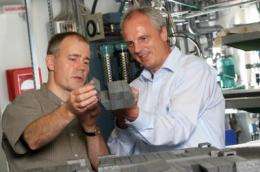Fitting squares into circles

Particle filters are standard in the basic fittings for cars. Construction machines, city buses and garbage trucks must now follow suit. This can be achieved effectively and inexpensively thanks to a new material and design for ceramic filters developed by Fraunhofer researchers.
From 2011, new EU guidelines for emission values will apply. The aim is to reduce particle emissions by up to 95 per cent. Off-road vehicles such as diggers and fork-lift trucks, but also city buses and garbage trucks, will then have to be fitted with filters. Retrofitting is also worthwhile in view of the vehicles' long lives and high purchasing costs. Until now, such special engine variants have been catered for with basic geometric forms similar to those used for car filters, i.e. squares.
The disadvantage is that in order to fit the square filters into the circular pipes, approximately 20 per cent of the material has to be cut away using expensive diamond cutters - costly waste. There's a better way of doing this, figured Jörg Adler and Dr. Reinhard Lenk from the Fraunhofer Institute for Ceramic Technologies and Systems IKTS in Dresden. Based on a material patented at the IKTS, a porous silicon carbide ceramic, they developed a highly efficient ceramic diesel particle filter for off-road applications together with HUSS Umwelttechnik GmbH. They will be awarded with one of the 2009 Joseph von Fraunhofer prizes for their work.
The material was adapted for use in a diesel particle filter in terms of size, distribution and volume of its pores. The raw materials are comparatively inexpensive and can be handled at lower temperatures as well. "We agonized over the basic shape of the filter segments," says Jörg Adler. A four-cornered trapezium was the result from which square-edged or circular surfaces can be fitted together without any wastage. The channels in the segments are three-cornered, not square, providing a larger filter surface. This means that, fitted behind the engine, it takes longer for sooty particles to accumulate in the individual channels and to reach the stage where they must be burnt off. Following the material and geometric form, it was then necessary to develop technologies suitable for series production. With a team of colleagues, the scientists tested all the work steps in a pilot production run at the institute and coordinated them with one another.
Clean Diesel Ceramics GmbH, a subsidiary of HUSS, was established to produce the ceramic filters. Sponsored by the Saxon State Ministry for Economic Affairs and Labor, the company started its operations in May 2008. "We have also thought about the series at all stages of the development and defined the conditions for it with our partner," says Dr. Lenk. "Some of the CDC staff members were initially directly involved in the project work at the institute, in order to simplify the transfer to production."
Source: Fraunhofer-Gesellschaft (news : web)


















